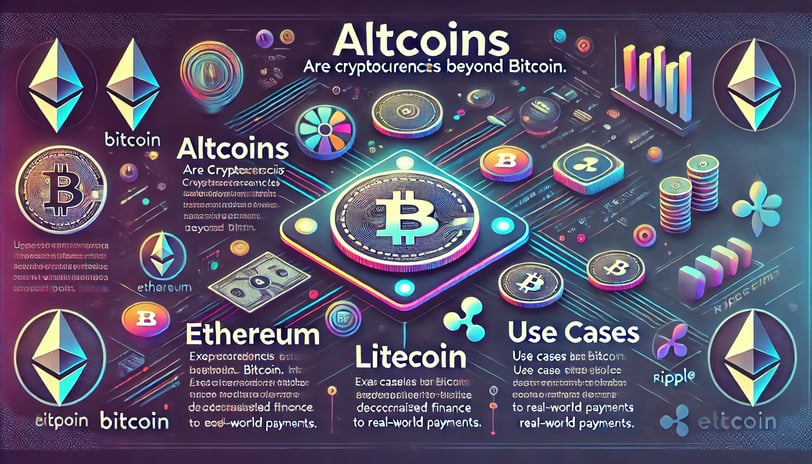Altcoins: My Journey into the World of Crypto Beyond Bitcoin
Cryptocurrency is like stepping into a bustling digital bazaar where every coin seems to have its own unique story. My first encounter with the term altcoin felt like discovering a secret menu at my favorite café—exciting yet a bit overwhelming. Bitcoin may dominate the headlines, but what about the "others"? What about the underdogs—the altcoins? As a second-year university student with a passion for tech and finance, I decided to dive deeper. Here's what I've learned about altcoins, sprinkled with my personal experiences, insights, and a fair bit of trial and error.
Ravinder Kumar Sharma
12/9/20243 min read


That One Crypto Chat That Changed Everything
It all started during a late-night group study session. A friend casually mentioned Ethereum, and I blurted out, “Isn’t Bitcoin the only cryptocurrency?” Cue laughter. I felt like someone who had just learned there’s more to coffee than plain black. Intrigued (and slightly embarrassed), I decided to explore this cryptic world. Little did I know that "altcoins" would soon become a fascinating rabbit hole for me.
What Are Altcoins Anyway?
To put it simply, altcoins are cryptocurrencies other than Bitcoin. Think of them as Bitcoin's younger siblings—often overshadowed but brimming with potential. Some popular altcoins include Ethereum, Litecoin, and Ripple (XRP). As of 2024, there are over 23,000 cryptocurrencies in existence, and most of them are altcoins. These coins serve various purposes, from powering decentralized applications to enabling faster and cheaper transactions.
Main Point 1: My First Altcoin Investment – A Lesson in Risk and Reward
I decided to invest in Ethereum (ETH), the second-largest cryptocurrency by market cap. Why? Because Ethereum felt like the cool kid in the crypto world. It wasn’t just a currency; it was a platform for creating decentralized apps (dApps) and smart contracts. "This has to be the future," I thought.
The Ups and Downs: My $100 investment quickly grew to $150 within weeks. I felt like a genius. But then, a market dip brought it down to $80. That’s when I learned my first lesson: crypto markets are volatile. A single tweet or global event can send prices soaring or plummeting.
Data Backs It Up: According to a 2023 report by CoinMarketCap, the average cryptocurrency experiences a daily price swing of 5-10%, far higher than traditional stocks. This makes altcoins both exciting and risky.
Takeaway: Altcoin investing is not for the faint-hearted. It’s crucial to only invest what you can afford to lose and to diversify your portfolio. As a student, I had to resist the temptation of putting all my savings into one shiny coin.
Main Point 2: Not All That Glitters Is Gold (Or Crypto)
After Ethereum, I ventured into lesser-known coins like Dogecoin and Shiba Inu. Why? Because memes are irresistible. Plus, the idea of making quick money was enticing. However, I quickly realized the dark side of altcoins—hype doesn’t equal value.
Scams and Rug Pulls: Did you know that in 2021 alone, crypto scams resulted in losses of over $14 billion? (Chainalysis, 2022). Some altcoins are launched with no real use case, solely to exploit investor enthusiasm. I nearly fell for a "promising" coin that turned out to be a pump-and-dump scheme. Thankfully, a bit of research saved me.
What I’ve Learned: Always do your homework. Look for coins with a clear purpose, active development teams, and supportive communities. If something feels too good to be true, it probably is. For example, I now look at metrics like market capitalization, volume, and developer activity before considering an investment.
Main Point 3: Beyond Investing—The Real Use Cases of Altcoins
Altcoins aren’t just speculative assets; they’re driving innovation. Take Ethereum, for instance. Its blockchain enables decentralized finance (DeFi) platforms, non-fungible tokens (NFTs), and even gaming economies. Then there’s Ripple (XRP), which aims to revolutionize cross-border payments by making them faster and cheaper.
Fun Fact: The average international bank transfer takes 1-5 business days and costs around 6.5% of the transaction value. Ripple can complete the same transfer in seconds with minimal fees (World Bank, 2023).
A Personal Insight: I once used a stablecoin called USDT (Tether) to pay for an online course. It was fast, hassle-free, and felt futuristic. This experience opened my eyes to how altcoins are reshaping real-world transactions.
My Perspective: Altcoins are more than digital money. They’re tools for building decentralized systems that could democratize finance, healthcare, and even governance. Isn’t that worth exploring?
The Emotional Rollercoaster of Being an Altcoin Enthusiast
Being involved with altcoins is like riding a rollercoaster blindfolded. One day, you're thrilled by gains; the next, you're questioning your life choices. What keeps me going is the sense of curiosity and the belief that we're witnessing the dawn of a new financial era.
I’ve also found humor to be a coping mechanism. There’s an entire meme culture around crypto, from jokes about "HODLing" (holding on for dear life) to memes about buying dips (and regretting it when the dip dips further).
Conclusion: What Altcoins Have Taught Me
Exploring altcoins has been an exhilarating journey of highs, lows, and plenty of learning. It’s taught me to take calculated risks, embrace uncertainty, and appreciate the power of innovation. But more importantly, it’s shown me that the crypto world is as much about people and communities as it is about technology.
So, if you’re curious about altcoins, my advice is simple: start small, stay informed, and enjoy the ride. Who knows? You might just uncover the next big thing—or at least have some great stories to share.
What’s your take on altcoins? I’d love to hear your thoughts in the comments. Let’s navigate this crypto journey together! 🚀
Thankyou For Reading:)
